remote control CHEVROLET COLORADO 2021 Duramax Diesel Supplement
[x] Cancel search | Manufacturer: CHEVROLET, Model Year: 2021, Model line: COLORADO, Model: CHEVROLET COLORADO 2021Pages: 89, PDF Size: 1.9 MB
Page 38 of 89
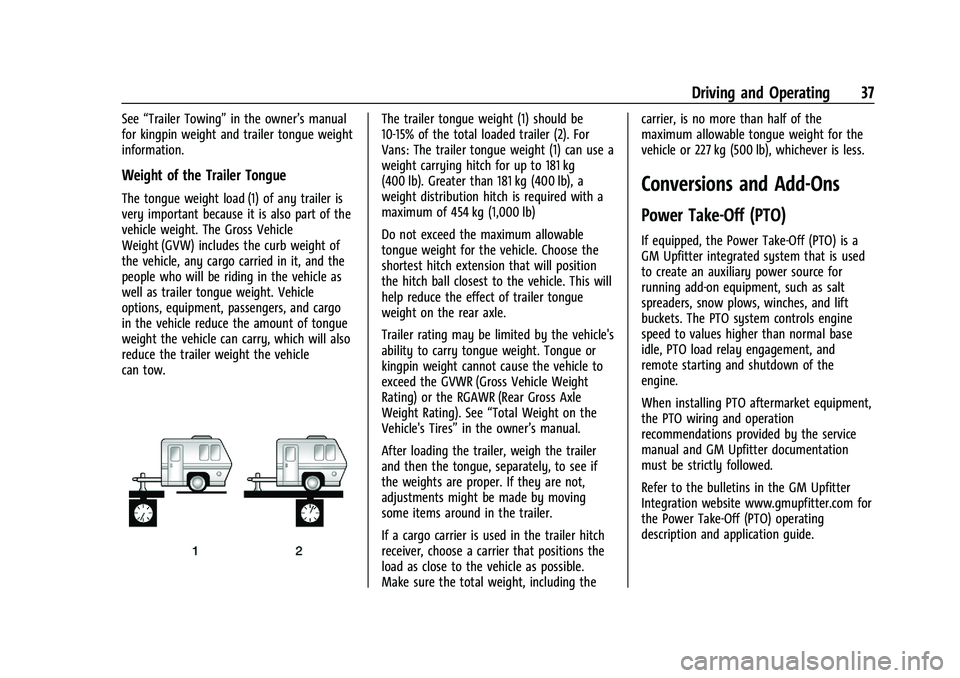
Chevrolet/GMC 2.8L Duramax Diesel Engine Supplement (GMNA-Localizing-
U.S./Canada-14465442) - 2021 - CRC - 2/3/20
Driving and Operating 37
SeeŌĆ£Trailer TowingŌĆØ in the ownerŌĆÖs manual
for kingpin weight and trailer tongue weight
information.
Weight of the Trailer Tongue
The tongue weight load (1) of any trailer is
very important because it is also part of the
vehicle weight. The Gross Vehicle
Weight (GVW) includes the curb weight of
the vehicle, any cargo carried in it, and the
people who will be riding in the vehicle as
well as trailer tongue weight. Vehicle
options, equipment, passengers, and cargo
in the vehicle reduce the amount of tongue
weight the vehicle can carry, which will also
reduce the trailer weight the vehicle
can tow.
The trailer tongue weight (1) should be
10-15% of the total loaded trailer (2). For
Vans: The trailer tongue weight (1) can use a
weight carrying hitch for up to 181 kg
(400 lb). Greater than 181 kg (400 lb), a
weight distribution hitch is required with a
maximum of 454 kg (1,000 lb)
Do not exceed the maximum allowable
tongue weight for the vehicle. Choose the
shortest hitch extension that will position
the hitch ball closest to the vehicle. This will
help reduce the effect of trailer tongue
weight on the rear axle.
Trailer rating may be limited by the vehicle's
ability to carry tongue weight. Tongue or
kingpin weight cannot cause the vehicle to
exceed the GVWR (Gross Vehicle Weight
Rating) or the RGAWR (Rear Gross Axle
Weight Rating). See ŌĆ£Total Weight on the
Vehicle's TiresŌĆØ in the ownerŌĆÖs manual.
After loading the trailer, weigh the trailer
and then the tongue, separately, to see if
the weights are proper. If they are not,
adjustments might be made by moving
some items around in the trailer.
If a cargo carrier is used in the trailer hitch
receiver, choose a carrier that positions the
load as close to the vehicle as possible.
Make sure the total weight, including the carrier, is no more than half of the
maximum allowable tongue weight for the
vehicle or 227 kg (500 lb), whichever is less.
Conversions and Add-Ons
Power Take-Off (PTO)
If equipped, the Power Take-Off (PTO) is a
GM Upfitter integrated system that is used
to create an auxiliary power source for
running add-on equipment, such as salt
spreaders, snow plows, winches, and lift
buckets. The PTO system controls engine
speed to values higher than normal base
idle, PTO load relay engagement, and
remote starting and shutdown of the
engine.
When installing PTO aftermarket equipment,
the PTO wiring and operation
recommendations provided by the service
manual and GM Upfitter documentation
must be strictly followed.
Refer to the bulletins in the GM Upfitter
Integration website www.gmupfitter.com for
the Power Take-Off (PTO) operating
description and application guide.
Page 39 of 89
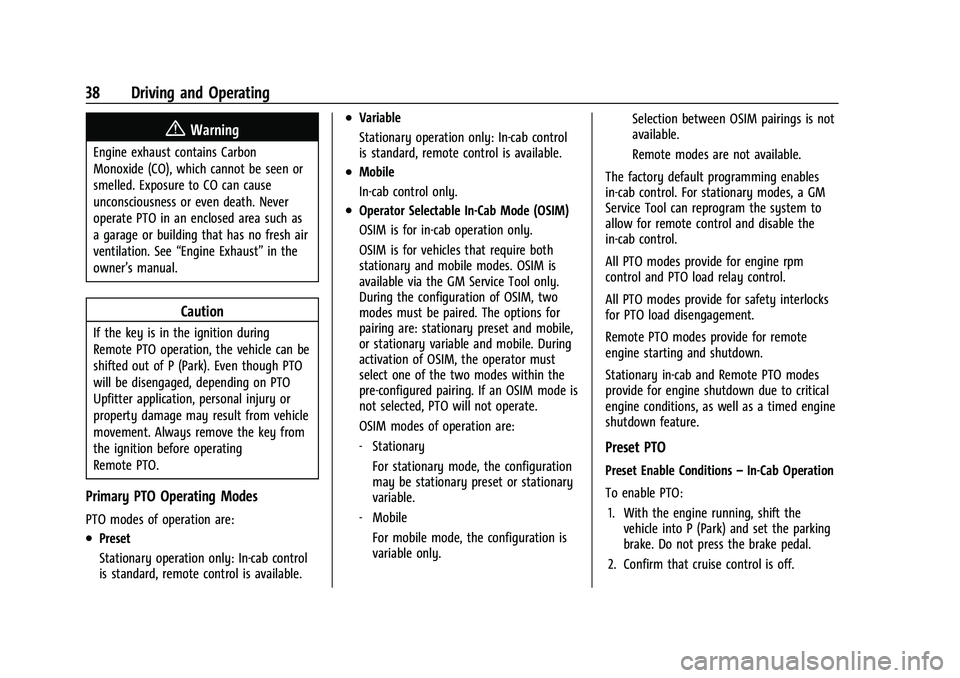
Chevrolet/GMC 2.8L Duramax Diesel Engine Supplement (GMNA-Localizing-
U.S./Canada-14465442) - 2021 - CRC - 2/3/20
38 Driving and Operating
{Warning
Engine exhaust contains Carbon
Monoxide (CO), which cannot be seen or
smelled. Exposure to CO can cause
unconsciousness or even death. Never
operate PTO in an enclosed area such as
a garage or building that has no fresh air
ventilation. SeeŌĆ£Engine ExhaustŌĆØ in the
ownerŌĆÖs manual.
Caution
If the key is in the ignition during
Remote PTO operation, the vehicle can be
shifted out of P (Park). Even though PTO
will be disengaged, depending on PTO
Upfitter application, personal injury or
property damage may result from vehicle
movement. Always remove the key from
the ignition before operating
Remote PTO.
Primary PTO Operating Modes
PTO modes of operation are:
.Preset
Stationary operation only: In-cab control
is standard, remote control is available.
.Variable
Stationary operation only: In-cab control
is standard, remote control is available.
.Mobile
In-cab control only.
.Operator Selectable In-Cab Mode (OSIM)
OSIM is for in-cab operation only.
OSIM is for vehicles that require both
stationary and mobile modes. OSIM is
available via the GM Service Tool only.
During the configuration of OSIM, two
modes must be paired. The options for
pairing are: stationary preset and mobile,
or stationary variable and mobile. During
activation of OSIM, the operator must
select one of the two modes within the
pre-configured pairing. If an OSIM mode is
not selected, PTO will not operate.
OSIM modes of operation are:
ŌĆÉ Stationary
For stationary mode, the configuration
may be stationary preset or stationary
variable.
ŌĆÉ Mobile
For mobile mode, the configuration is
variable only. Selection between OSIM pairings is not
available.
Remote modes are not available.
The factory default programming enables
in-cab control. For stationary modes, a GM
Service Tool can reprogram the system to
allow for remote control and disable the
in-cab control.
All PTO modes provide for engine rpm
control and PTO load relay control.
All PTO modes provide for safety interlocks
for PTO load disengagement.
Remote PTO modes provide for remote
engine starting and shutdown.
Stationary in-cab and Remote PTO modes
provide for engine shutdown due to critical
engine conditions, as well as a timed engine
shutdown feature.
Preset PTO
Preset Enable Conditions ŌĆōIn-Cab Operation
To enable PTO: 1. With the engine running, shift the vehicle into P (Park) and set the parking
brake. Do not press the brake pedal.
2. Confirm that cruise control is off.
Page 40 of 89
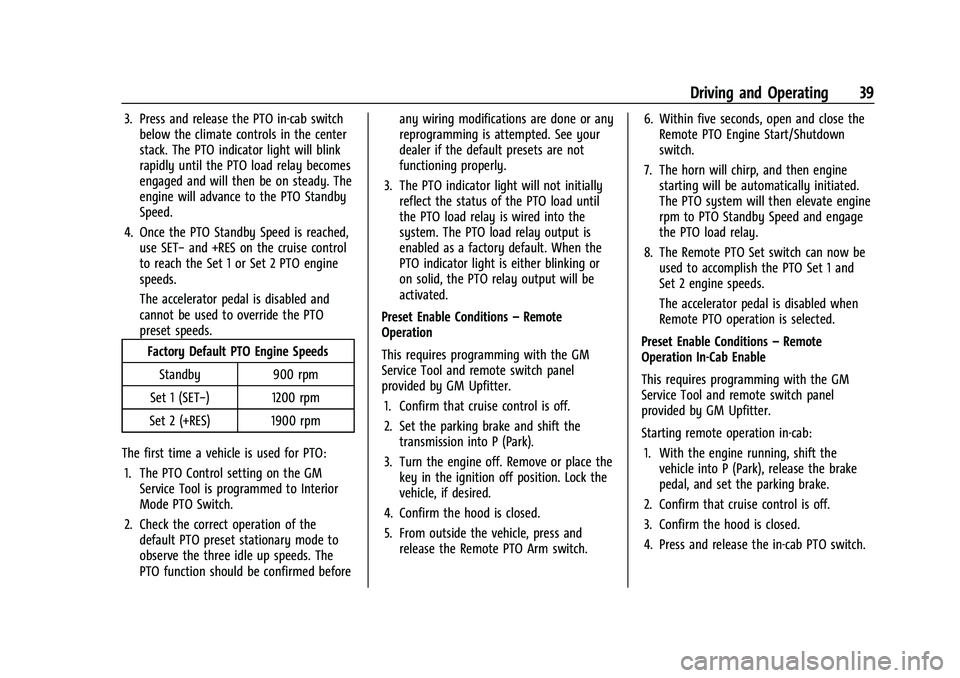
Chevrolet/GMC 2.8L Duramax Diesel Engine Supplement (GMNA-Localizing-
U.S./Canada-14465442) - 2021 - CRC - 2/3/20
Driving and Operating 39
3. Press and release the PTO in-cab switchbelow the climate controls in the center
stack. The PTO indicator light will blink
rapidly until the PTO load relay becomes
engaged and will then be on steady. The
engine will advance to the PTO Standby
Speed.
4. Once the PTO Standby Speed is reached, use SETŌłÆ and +RES on the cruise control
to reach the Set 1 or Set 2 PTO engine
speeds.
The accelerator pedal is disabled and
cannot be used to override the PTO
preset speeds.
Factory Default PTO Engine Speeds
Standby 900 rpm
Set 1 (SETŌłÆ) 1200 rpm
Set 2 (+RES) 1900 rpm
The first time a vehicle is used for PTO: 1. The PTO Control setting on the GM Service Tool is programmed to Interior
Mode PTO Switch.
2. Check the correct operation of the default PTO preset stationary mode to
observe the three idle up speeds. The
PTO function should be confirmed before any wiring modifications are done or any
reprogramming is attempted. See your
dealer if the default presets are not
functioning properly.
3. The PTO indicator light will not initially reflect the status of the PTO load until
the PTO load relay is wired into the
system. The PTO load relay output is
enabled as a factory default. When the
PTO indicator light is either blinking or
on solid, the PTO relay output will be
activated.
Preset Enable Conditions ŌĆōRemote
Operation
This requires programming with the GM
Service Tool and remote switch panel
provided by GM Upfitter.
1. Confirm that cruise control is off.
2. Set the parking brake and shift the transmission into P (Park).
3. Turn the engine off. Remove or place the key in the ignition off position. Lock the
vehicle, if desired.
4. Confirm the hood is closed.
5. From outside the vehicle, press and release the Remote PTO Arm switch. 6. Within five seconds, open and close the
Remote PTO Engine Start/Shutdown
switch.
7. The horn will chirp, and then engine starting will be automatically initiated.
The PTO system will then elevate engine
rpm to PTO Standby Speed and engage
the PTO load relay.
8. The Remote PTO Set switch can now be used to accomplish the PTO Set 1 and
Set 2 engine speeds.
The accelerator pedal is disabled when
Remote PTO operation is selected.
Preset Enable Conditions ŌĆōRemote
Operation In-Cab Enable
This requires programming with the GM
Service Tool and remote switch panel
provided by GM Upfitter.
Starting remote operation in-cab:
1. With the engine running, shift the vehicle into P (Park), release the brake
pedal, and set the parking brake.
2. Confirm that cruise control is off.
3. Confirm the hood is closed.
4. Press and release the in-cab PTO switch.
Page 41 of 89
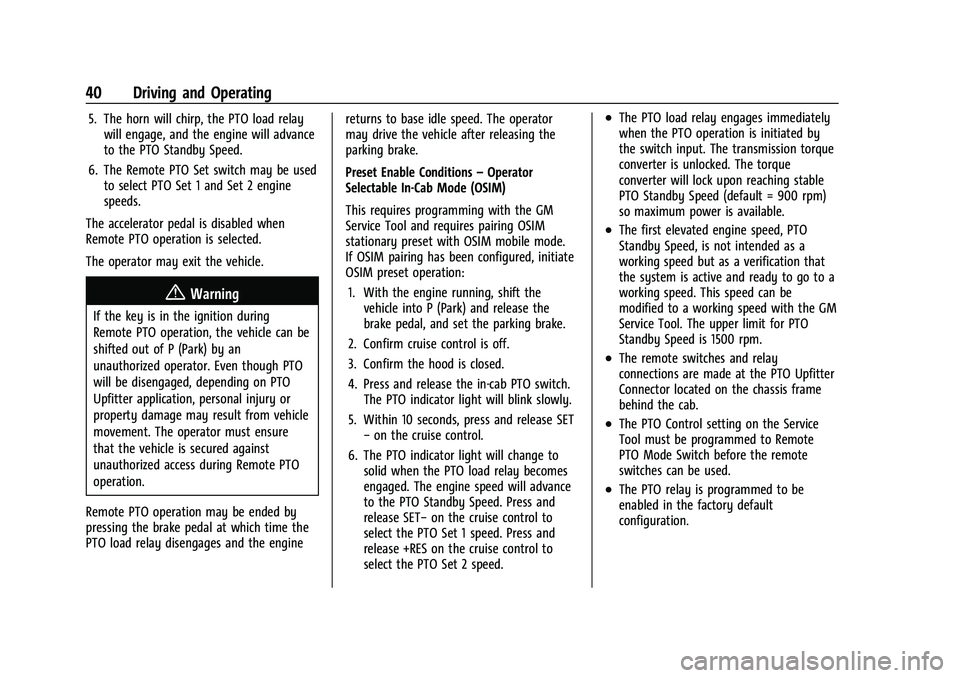
Chevrolet/GMC 2.8L Duramax Diesel Engine Supplement (GMNA-Localizing-
U.S./Canada-14465442) - 2021 - CRC - 2/3/20
40 Driving and Operating
5. The horn will chirp, the PTO load relaywill engage, and the engine will advance
to the PTO Standby Speed.
6. The Remote PTO Set switch may be used to select PTO Set 1 and Set 2 engine
speeds.
The accelerator pedal is disabled when
Remote PTO operation is selected.
The operator may exit the vehicle.
{Warning
If the key is in the ignition during
Remote PTO operation, the vehicle can be
shifted out of P (Park) by an
unauthorized operator. Even though PTO
will be disengaged, depending on PTO
Upfitter application, personal injury or
property damage may result from vehicle
movement. The operator must ensure
that the vehicle is secured against
unauthorized access during Remote PTO
operation.
Remote PTO operation may be ended by
pressing the brake pedal at which time the
PTO load relay disengages and the engine returns to base idle speed. The operator
may drive the vehicle after releasing the
parking brake.
Preset Enable Conditions
ŌĆōOperator
Selectable In-Cab Mode (OSIM)
This requires programming with the GM
Service Tool and requires pairing OSIM
stationary preset with OSIM mobile mode.
If OSIM pairing has been configured, initiate
OSIM preset operation:
1. With the engine running, shift the vehicle into P (Park) and release the
brake pedal, and set the parking brake.
2. Confirm cruise control is off.
3. Confirm the hood is closed.
4. Press and release the in-cab PTO switch. The PTO indicator light will blink slowly.
5. Within 10 seconds, press and release SET ŌłÆon the cruise control.
6. The PTO indicator light will change to solid when the PTO load relay becomes
engaged. The engine speed will advance
to the PTO Standby Speed. Press and
release SETŌłÆ on the cruise control to
select the PTO Set 1 speed. Press and
release +RES on the cruise control to
select the PTO Set 2 speed.
.The PTO load relay engages immediately
when the PTO operation is initiated by
the switch input. The transmission torque
converter is unlocked. The torque
converter will lock upon reaching stable
PTO Standby Speed (default = 900 rpm)
so maximum power is available.
.The first elevated engine speed, PTO
Standby Speed, is not intended as a
working speed but as a verification that
the system is active and ready to go to a
working speed. This speed can be
modified to a working speed with the GM
Service Tool. The upper limit for PTO
Standby Speed is 1500 rpm.
.The remote switches and relay
connections are made at the PTO Upfitter
Connector located on the chassis frame
behind the cab.
.The PTO Control setting on the Service
Tool must be programmed to Remote
PTO Mode Switch before the remote
switches can be used.
.The PTO relay is programmed to be
enabled in the factory default
configuration.
Page 42 of 89
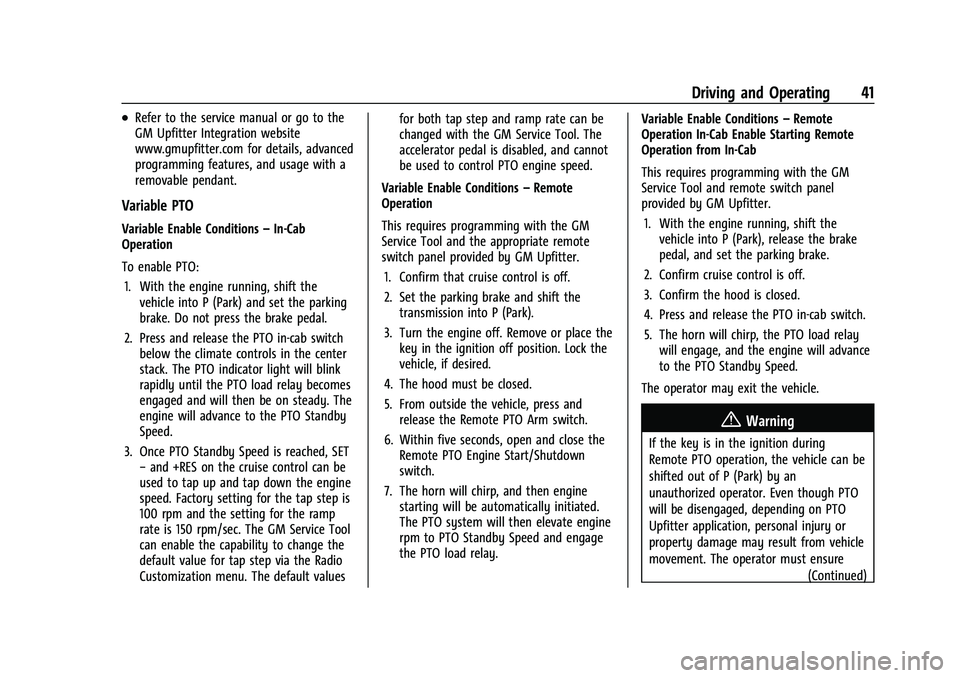
Chevrolet/GMC 2.8L Duramax Diesel Engine Supplement (GMNA-Localizing-
U.S./Canada-14465442) - 2021 - CRC - 2/3/20
Driving and Operating 41
.Refer to the service manual or go to the
GM Upfitter Integration website
www.gmupfitter.com for details, advanced
programming features, and usage with a
removable pendant.
Variable PTO
Variable Enable ConditionsŌĆōIn-Cab
Operation
To enable PTO:
1. With the engine running, shift the vehicle into P (Park) and set the parking
brake. Do not press the brake pedal.
2. Press and release the PTO in-cab switch below the climate controls in the center
stack. The PTO indicator light will blink
rapidly until the PTO load relay becomes
engaged and will then be on steady. The
engine will advance to the PTO Standby
Speed.
3. Once PTO Standby Speed is reached, SET ŌłÆand +RES on the cruise control can be
used to tap up and tap down the engine
speed. Factory setting for the tap step is
100 rpm and the setting for the ramp
rate is 150 rpm/sec. The GM Service Tool
can enable the capability to change the
default value for tap step via the Radio
Customization menu. The default values for both tap step and ramp rate can be
changed with the GM Service Tool. The
accelerator pedal is disabled, and cannot
be used to control PTO engine speed.
Variable Enable Conditions ŌĆōRemote
Operation
This requires programming with the GM
Service Tool and the appropriate remote
switch panel provided by GM Upfitter.
1. Confirm that cruise control is off.
2. Set the parking brake and shift the transmission into P (Park).
3. Turn the engine off. Remove or place the key in the ignition off position. Lock the
vehicle, if desired.
4. The hood must be closed.
5. From outside the vehicle, press and release the Remote PTO Arm switch.
6. Within five seconds, open and close the Remote PTO Engine Start/Shutdown
switch.
7. The horn will chirp, and then engine starting will be automatically initiated.
The PTO system will then elevate engine
rpm to PTO Standby Speed and engage
the PTO load relay. Variable Enable Conditions
ŌĆōRemote
Operation In-Cab Enable Starting Remote
Operation from In-Cab
This requires programming with the GM
Service Tool and remote switch panel
provided by GM Upfitter.
1. With the engine running, shift the vehicle into P (Park), release the brake
pedal, and set the parking brake.
2. Confirm cruise control is off.
3. Confirm the hood is closed.
4. Press and release the PTO in-cab switch.
5. The horn will chirp, the PTO load relay will engage, and the engine will advance
to the PTO Standby Speed.
The operator may exit the vehicle.
{Warning
If the key is in the ignition during
Remote PTO operation, the vehicle can be
shifted out of P (Park) by an
unauthorized operator. Even though PTO
will be disengaged, depending on PTO
Upfitter application, personal injury or
property damage may result from vehicle
movement. The operator must ensure (Continued)
Page 43 of 89
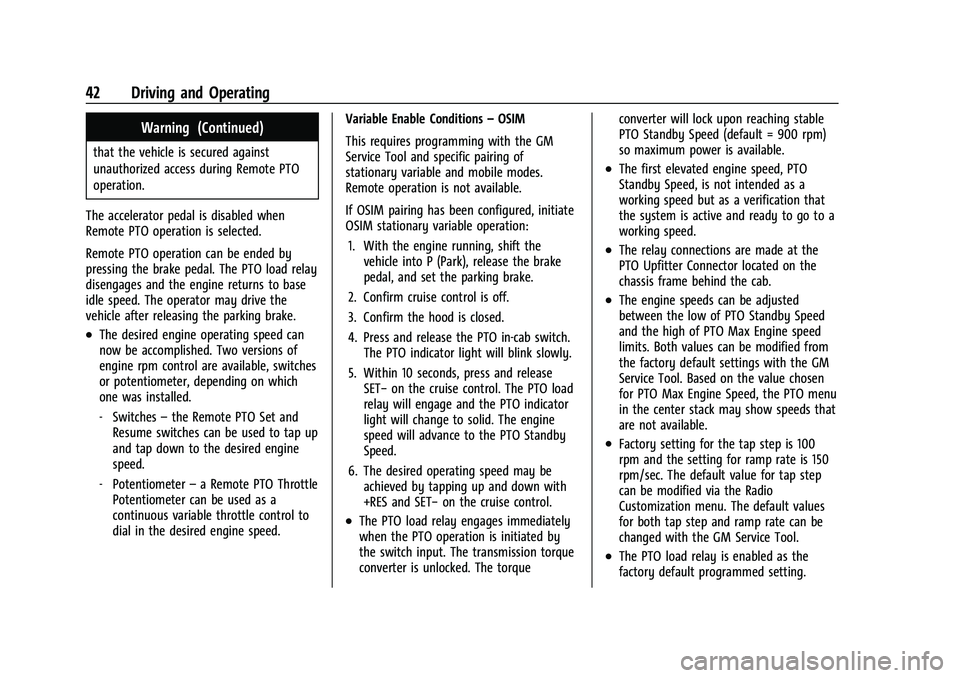
Chevrolet/GMC 2.8L Duramax Diesel Engine Supplement (GMNA-Localizing-
U.S./Canada-14465442) - 2021 - CRC - 2/3/20
42 Driving and Operating
Warning (Continued)
that the vehicle is secured against
unauthorized access during Remote PTO
operation.
The accelerator pedal is disabled when
Remote PTO operation is selected.
Remote PTO operation can be ended by
pressing the brake pedal. The PTO load relay
disengages and the engine returns to base
idle speed. The operator may drive the
vehicle after releasing the parking brake.
.The desired engine operating speed can
now be accomplished. Two versions of
engine rpm control are available, switches
or potentiometer, depending on which
one was installed.
ŌĆÉ Switches ŌĆōthe Remote PTO Set and
Resume switches can be used to tap up
and tap down to the desired engine
speed.
ŌĆÉ Potentiometer ŌĆōa Remote PTO Throttle
Potentiometer can be used as a
continuous variable throttle control to
dial in the desired engine speed. Variable Enable Conditions
ŌĆōOSIM
This requires programming with the GM
Service Tool and specific pairing of
stationary variable and mobile modes.
Remote operation is not available.
If OSIM pairing has been configured, initiate
OSIM stationary variable operation: 1. With the engine running, shift the vehicle into P (Park), release the brake
pedal, and set the parking brake.
2. Confirm cruise control is off.
3. Confirm the hood is closed.
4. Press and release the PTO in-cab switch. The PTO indicator light will blink slowly.
5. Within 10 seconds, press and release SETŌłÆ on the cruise control. The PTO load
relay will engage and the PTO indicator
light will change to solid. The engine
speed will advance to the PTO Standby
Speed.
6. The desired operating speed may be achieved by tapping up and down with
+RES and SETŌłÆ on the cruise control.
.The PTO load relay engages immediately
when the PTO operation is initiated by
the switch input. The transmission torque
converter is unlocked. The torque converter will lock upon reaching stable
PTO Standby Speed (default = 900 rpm)
so maximum power is available.
.The first elevated engine speed, PTO
Standby Speed, is not intended as a
working speed but as a verification that
the system is active and ready to go to a
working speed.
.The relay connections are made at the
PTO Upfitter Connector located on the
chassis frame behind the cab.
.The engine speeds can be adjusted
between the low of PTO Standby Speed
and the high of PTO Max Engine speed
limits. Both values can be modified from
the factory default settings with the GM
Service Tool. Based on the value chosen
for PTO Max Engine Speed, the PTO menu
in the center stack may show speeds that
are not available.
.Factory setting for the tap step is 100
rpm and the setting for ramp rate is 150
rpm/sec. The default value for tap step
can be modified via the Radio
Customization menu. The default values
for both tap step and ramp rate can be
changed with the GM Service Tool.
.The PTO load relay is enabled as the
factory default programmed setting.
Page 44 of 89
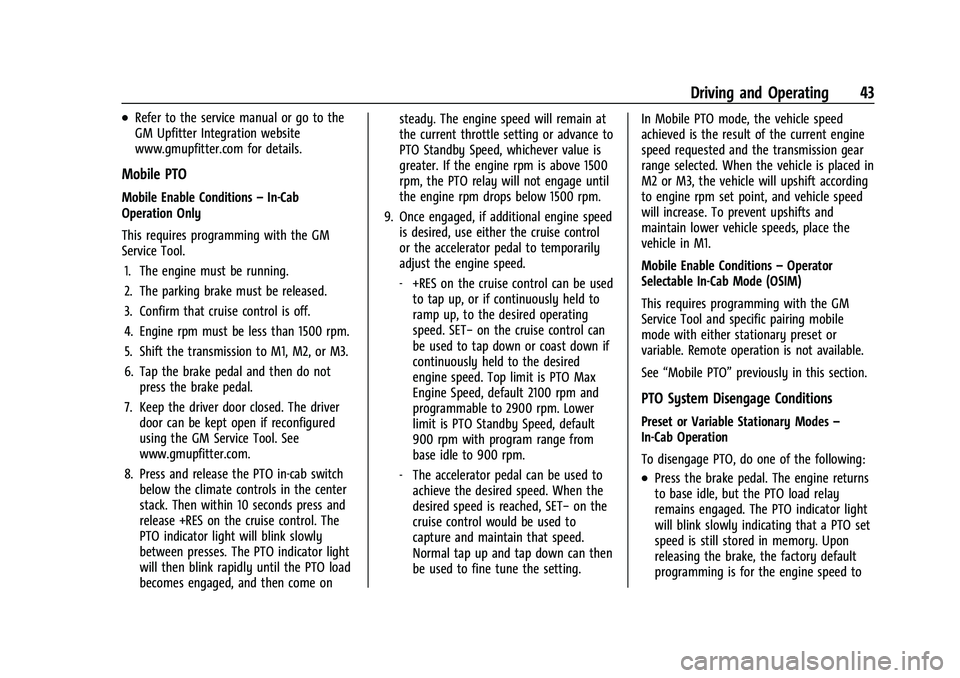
Chevrolet/GMC 2.8L Duramax Diesel Engine Supplement (GMNA-Localizing-
U.S./Canada-14465442) - 2021 - CRC - 2/3/20
Driving and Operating 43
.Refer to the service manual or go to the
GM Upfitter Integration website
www.gmupfitter.com for details.
Mobile PTO
Mobile Enable ConditionsŌĆōIn-Cab
Operation Only
This requires programming with the GM
Service Tool.
1. The engine must be running.
2. The parking brake must be released.
3. Confirm that cruise control is off.
4. Engine rpm must be less than 1500 rpm.
5. Shift the transmission to M1, M2, or M3.
6. Tap the brake pedal and then do not press the brake pedal.
7. Keep the driver door closed. The driver door can be kept open if reconfigured
using the GM Service Tool. See
www.gmupfitter.com.
8. Press and release the PTO in-cab switch below the climate controls in the center
stack. Then within 10 seconds press and
release +RES on the cruise control. The
PTO indicator light will blink slowly
between presses. The PTO indicator light
will then blink rapidly until the PTO load
becomes engaged, and then come on steady. The engine speed will remain at
the current throttle setting or advance to
PTO Standby Speed, whichever value is
greater. If the engine rpm is above 1500
rpm, the PTO relay will not engage until
the engine rpm drops below 1500 rpm.
9. Once engaged, if additional engine speed is desired, use either the cruise control
or the accelerator pedal to temporarily
adjust the engine speed.
ŌĆÉ+RES on the cruise control can be used
to tap up, or if continuously held to
ramp up, to the desired operating
speed. SETŌłÆ on the cruise control can
be used to tap down or coast down if
continuously held to the desired
engine speed. Top limit is PTO Max
Engine Speed, default 2100 rpm and
programmable to 2900 rpm. Lower
limit is PTO Standby Speed, default
900 rpm with program range from
base idle to 900 rpm.
ŌĆÉ The accelerator pedal can be used to
achieve the desired speed. When the
desired speed is reached, SETŌłÆ on the
cruise control would be used to
capture and maintain that speed.
Normal tap up and tap down can then
be used to fine tune the setting. In Mobile PTO mode, the vehicle speed
achieved is the result of the current engine
speed requested and the transmission gear
range selected. When the vehicle is placed in
M2 or M3, the vehicle will upshift according
to engine rpm set point, and vehicle speed
will increase. To prevent upshifts and
maintain lower vehicle speeds, place the
vehicle in M1.
Mobile Enable Conditions
ŌĆōOperator
Selectable In-Cab Mode (OSIM)
This requires programming with the GM
Service Tool and specific pairing mobile
mode with either stationary preset or
variable. Remote operation is not available.
See ŌĆ£Mobile PTOŌĆØ previously in this section.
PTO System Disengage Conditions
Preset or Variable Stationary Modes ŌĆō
In-Cab Operation
To disengage PTO, do one of the following:
.Press the brake pedal. The engine returns
to base idle, but the PTO load relay
remains engaged. The PTO indicator light
will blink slowly indicating that a PTO set
speed is still stored in memory. Upon
releasing the brake, the factory default
programming is for the engine speed to
Page 45 of 89

Chevrolet/GMC 2.8L Duramax Diesel Engine Supplement (GMNA-Localizing-
U.S./Canada-14465442) - 2021 - CRC - 2/3/20
44 Driving and Operating
remain at curb idle. A press and release
of +RES on the cruise control will restore
engine rpm to the last PTO set speed. The
PTO system can also be programmed to
return engine rpm to the PTO Standby
Speed setting.
.Press*on the cruise control. The engine
returns to base idle, but the PTO load
relay remains engaged. The PTO indicator
light will blink slowly indicating that a
PTO set speed is still stored in memory.
Activating +RES on the cruise control will
restore engine rpm to the last PTO set
speed.
.Press and release the PTO in-cab switch.
The PTO load relay disengages and the
engine returns to base idle. The PTO
indicator light will turn off, indicating the
PTO load relay is disengaged and the
stored set speed has been cleared from
memory.
Stationary Modes (Preset or Variable) ŌĆō
Remote Control
To disengage PTO:
.Open the Remote PTO Engine Start/
Shutdown switch. Load relay disengages
and the engine will stop.
.If equipped, press the PTO Emergency
Stop switch. Load relay disengages and
the engine will stop. Refer to the bulletins
in the GM Upfitter Integration website
www.gmupfitter.com for the Power
Take-Off (PTO) operating description and
application guide.
.With the key in the ignition and rotated
to the RUN position, press the brake
pedal. The PTO load relay disengages and
the engine returns to base idle speed. The
operator may drive the vehicle.
Stationary Modes will also disengage if:
.Vehicle movement is detected.
.The parking brake is released.
.The transmission is shifted out of
P (Park).
.The ignition is cycled from RUN to OFF.
.The PTO feedback signal is lost indicating
the load is disengaged if used. See
www.gmupfitter.com.
.Cruise control becomes enabled.
.Timed auto-engine shutdown: This feature
will shut down the engine automatically
after a predefined time. PTO must be
operational for this function to be active.
.Engine shutdown based on critical engine
or PTO system fault conditions: This
feature will shut down the engine when
PTO is operating if a critical engine
condition such as low oil, low oil pressure,
hot engine, hot transmission, low fuel,
or Diesel Particulate Filter regeneration is
detected by the vehicle system. If PTO
operation is continued when critical
engine conditions are present, a horn
chirp warning will occur after 30ŌĆō
60 seconds. The engine will shut down
two minutes after the horn warning. The
engine can be restarted with the ignition
key or with the Remote PTO engine start
controls. The horn warning and engine
shutdown will again occur if the critical
engine condition is still present.
Resume memory speed is cleared for the
above actions.
When Remote PTO engine starting has been
initialized with the ignition key in the RUN
position, the shift lever will remain locked if
the brake pedal is pressed and a shift from
P (Park) is attempted while the engine is
running and PTO is active (standby mode).
A shift out of P (Park) will not be allowed
until one of the following actions is taken
by the vehicle operator:
Page 46 of 89
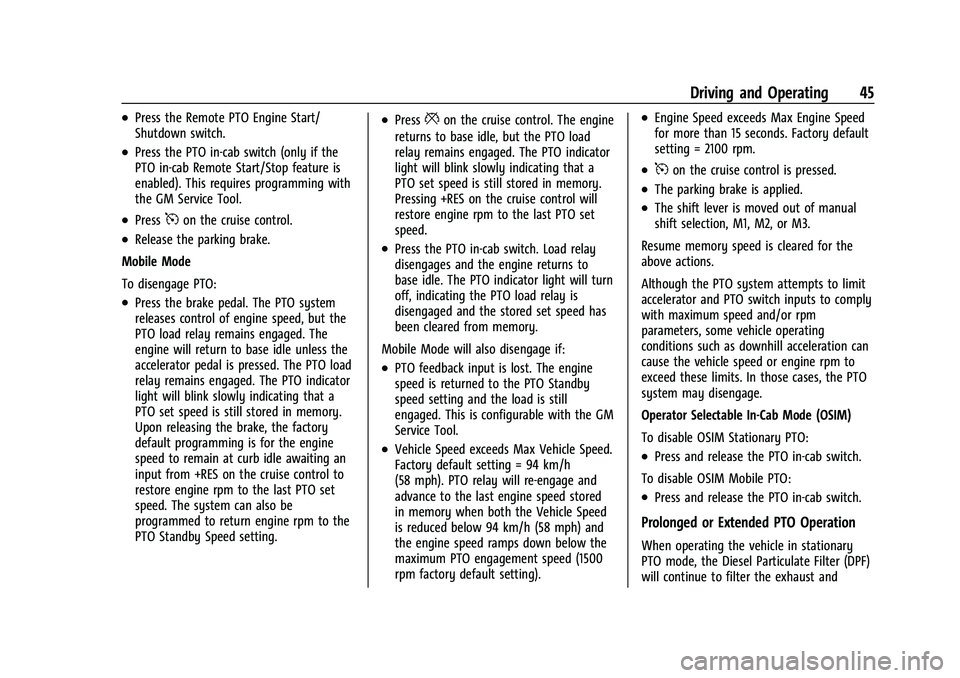
Chevrolet/GMC 2.8L Duramax Diesel Engine Supplement (GMNA-Localizing-
U.S./Canada-14465442) - 2021 - CRC - 2/3/20
Driving and Operating 45
.Press the Remote PTO Engine Start/
Shutdown switch.
.Press the PTO in-cab switch (only if the
PTO in-cab Remote Start/Stop feature is
enabled). This requires programming with
the GM Service Tool.
.Press5on the cruise control.
.Release the parking brake.
Mobile Mode
To disengage PTO:
.Press the brake pedal. The PTO system
releases control of engine speed, but the
PTO load relay remains engaged. The
engine will return to base idle unless the
accelerator pedal is pressed. The PTO load
relay remains engaged. The PTO indicator
light will blink slowly indicating that a
PTO set speed is still stored in memory.
Upon releasing the brake, the factory
default programming is for the engine
speed to remain at curb idle awaiting an
input from +RES on the cruise control to
restore engine rpm to the last PTO set
speed. The system can also be
programmed to return engine rpm to the
PTO Standby Speed setting.
.Press*on the cruise control. The engine
returns to base idle, but the PTO load
relay remains engaged. The PTO indicator
light will blink slowly indicating that a
PTO set speed is still stored in memory.
Pressing +RES on the cruise control will
restore engine rpm to the last PTO set
speed.
.Press the PTO in-cab switch. Load relay
disengages and the engine returns to
base idle. The PTO indicator light will turn
off, indicating the PTO load relay is
disengaged and the stored set speed has
been cleared from memory.
Mobile Mode will also disengage if:
.PTO feedback input is lost. The engine
speed is returned to the PTO Standby
speed setting and the load is still
engaged. This is configurable with the GM
Service Tool.
.Vehicle Speed exceeds Max Vehicle Speed.
Factory default setting = 94 km/h
(58 mph). PTO relay will re-engage and
advance to the last engine speed stored
in memory when both the Vehicle Speed
is reduced below 94 km/h (58 mph) and
the engine speed ramps down below the
maximum PTO engagement speed (1500
rpm factory default setting).
.Engine Speed exceeds Max Engine Speed
for more than 15 seconds. Factory default
setting = 2100 rpm.
.5on the cruise control is pressed.
.The parking brake is applied.
.The shift lever is moved out of manual
shift selection, M1, M2, or M3.
Resume memory speed is cleared for the
above actions.
Although the PTO system attempts to limit
accelerator and PTO switch inputs to comply
with maximum speed and/or rpm
parameters, some vehicle operating
conditions such as downhill acceleration can
cause the vehicle speed or engine rpm to
exceed these limits. In those cases, the PTO
system may disengage.
Operator Selectable In-Cab Mode (OSIM)
To disable OSIM Stationary PTO:
.Press and release the PTO in-cab switch.
To disable OSIM Mobile PTO:
.Press and release the PTO in-cab switch.
Prolonged or Extended PTO Operation
When operating the vehicle in stationary
PTO mode, the Diesel Particulate Filter (DPF)
will continue to filter the exhaust and
Page 47 of 89
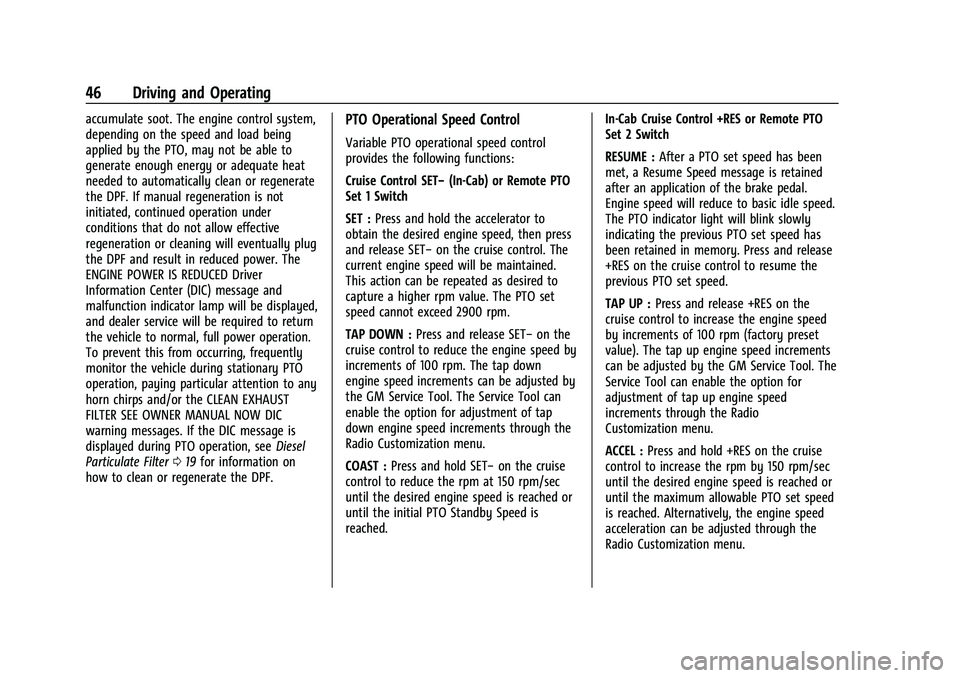
Chevrolet/GMC 2.8L Duramax Diesel Engine Supplement (GMNA-Localizing-
U.S./Canada-14465442) - 2021 - CRC - 2/3/20
46 Driving and Operating
accumulate soot. The engine control system,
depending on the speed and load being
applied by the PTO, may not be able to
generate enough energy or adequate heat
needed to automatically clean or regenerate
the DPF. If manual regeneration is not
initiated, continued operation under
conditions that do not allow effective
regeneration or cleaning will eventually plug
the DPF and result in reduced power. The
ENGINE POWER IS REDUCED Driver
Information Center (DIC) message and
malfunction indicator lamp will be displayed,
and dealer service will be required to return
the vehicle to normal, full power operation.
To prevent this from occurring, frequently
monitor the vehicle during stationary PTO
operation, paying particular attention to any
horn chirps and/or the CLEAN EXHAUST
FILTER SEE OWNER MANUAL NOW DIC
warning messages. If the DIC message is
displayed during PTO operation, seeDiesel
Particulate Filter 019 for information on
how to clean or regenerate the DPF.PTO Operational Speed Control
Variable PTO operational speed control
provides the following functions:
Cruise Control SETŌłÆ (In-Cab) or Remote PTO
Set 1 Switch
SET : Press and hold the accelerator to
obtain the desired engine speed, then press
and release SETŌłÆ on the cruise control. The
current engine speed will be maintained.
This action can be repeated as desired to
capture a higher rpm value. The PTO set
speed cannot exceed 2900 rpm.
TAP DOWN : Press and release SETŌłÆ on the
cruise control to reduce the engine speed by
increments of 100 rpm. The tap down
engine speed increments can be adjusted by
the GM Service Tool. The Service Tool can
enable the option for adjustment of tap
down engine speed increments through the
Radio Customization menu.
COAST : Press and hold SETŌłÆ on the cruise
control to reduce the rpm at 150 rpm/sec
until the desired engine speed is reached or
until the initial PTO Standby Speed is
reached. In-Cab Cruise Control +RES or Remote PTO
Set 2 Switch
RESUME :
After a PTO set speed has been
met, a Resume Speed message is retained
after an application of the brake pedal.
Engine speed will reduce to basic idle speed.
The PTO indicator light will blink slowly
indicating the previous PTO set speed has
been retained in memory. Press and release
+RES on the cruise control to resume the
previous PTO set speed.
TAP UP : Press and release +RES on the
cruise control to increase the engine speed
by increments of 100 rpm (factory preset
value). The tap up engine speed increments
can be adjusted by the GM Service Tool. The
Service Tool can enable the option for
adjustment of tap up engine speed
increments through the Radio
Customization menu.
ACCEL : Press and hold +RES on the cruise
control to increase the rpm by 150 rpm/sec
until the desired engine speed is reached or
until the maximum allowable PTO set speed
is reached. Alternatively, the engine speed
acceleration can be adjusted through the
Radio Customization menu.